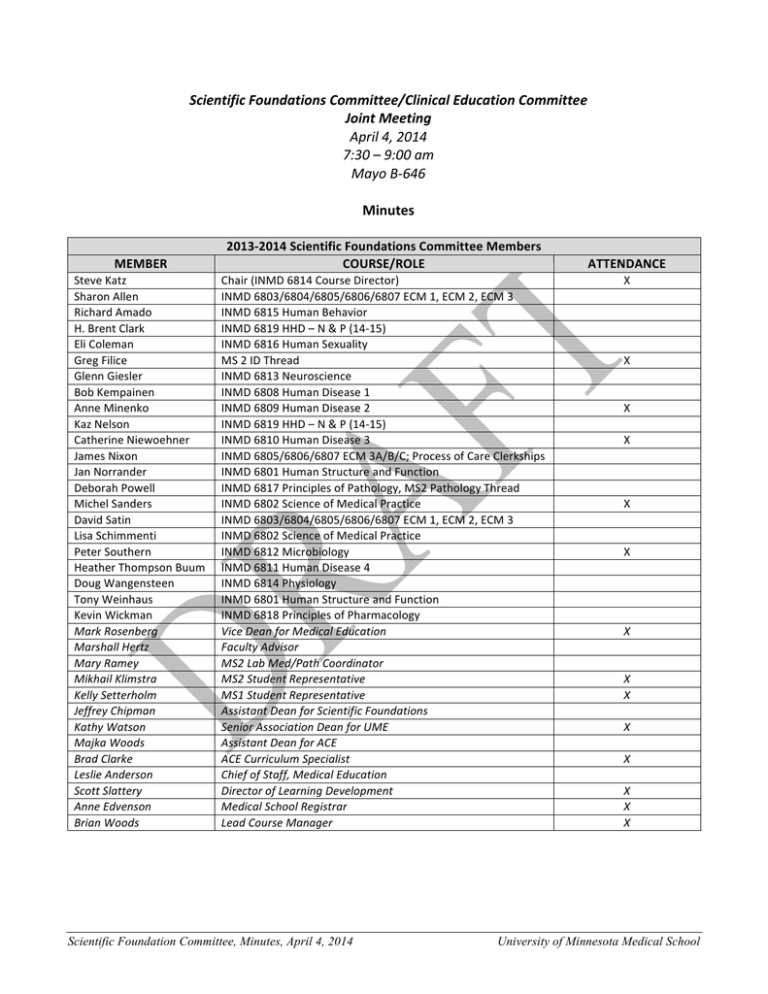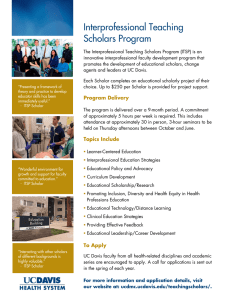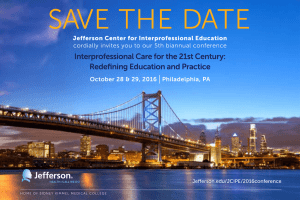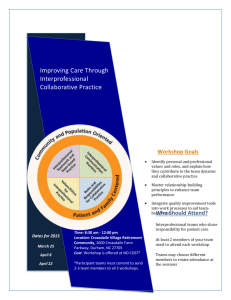Document 14777308
advertisement

Scientific Foundations Committee/Clinical Education Committee Joint Meeting April 4, 2014 7:30 – 9:00 am Mayo B-­‐646 Minutes MEMBER 2013-­‐2014 Scientific Foundations Committee Members COURSE/ROLE ATTENDANCE Steve Katz Sharon Allen Richard Amado H. Brent Clark Eli Coleman Greg Filice Glenn Giesler Bob Kempainen Anne Minenko Kaz Nelson Catherine Niewoehner James Nixon Jan Norrander Deborah Powell Michel Sanders David Satin Lisa Schimmenti Peter Southern Heather Thompson Buum Doug Wangensteen Tony Weinhaus Kevin Wickman Mark Rosenberg Marshall Hertz Mary Ramey Mikhail Klimstra Kelly Setterholm Jeffrey Chipman Kathy Watson Majka Woods Brad Clarke Leslie Anderson Scott Slattery Anne Edvenson Brian Woods Chair (INMD 6814 Course Director) INMD 6803/6804/6805/6806/6807 ECM 1, ECM 2, ECM 3 INMD 6815 Human Behavior INMD 6819 HHD – N & P (14-­‐15) INMD 6816 Human Sexuality MS 2 ID Thread INMD 6813 Neuroscience INMD 6808 Human Disease 1 INMD 6809 Human Disease 2 INMD 6819 HHD – N & P (14-­‐15) INMD 6810 Human Disease 3 INMD 6805/6806/6807 ECM 3A/B/C; Process of Care Clerkships INMD 6801 Human Structure and Function INMD 6817 Principles of Pathology, MS2 Pathology Thread INMD 6802 Science of Medical Practice INMD 6803/6804/6805/6806/6807 ECM 1, ECM 2, ECM 3 INMD 6802 Science of Medical Practice INMD 6812 Microbiology INMD 6811 Human Disease 4 INMD 6814 Physiology INMD 6801 Human Structure and Function INMD 6818 Principles of Pharmacology Vice Dean for Medical Education Faculty Advisor MS2 Lab Med/Path Coordinator MS2 Student Representative MS1 Student Representative Assistant Dean for Scientific Foundations Senior Association Dean for UME Assistant Dean for ACE ACE Curriculum Specialist Chief of Staff, Medical Education Director of Learning Development Medical School Registrar Lead Course Manager X X X X X X X X X X X X X X Scientific Foundation Committee, Minutes, April 4, 2014 University of Minnesota Medical School Gary Beaver Yasuko Yamamura Katherine Murray Sheila Specker Robert Acton Cornelius Lam Edward RG Santos Jennifer Hsia Paul Gleich James Pacala 2013-­‐2014 Clinical Education Committee Members CLERKSHIP/ROLE Chair INMD 6805/6806/6807 Essentials of Clinical Medicine 3A/B/C; Process of Care Clerkships EMMD 7500 Emergency Medicine FMCH 7600 Family Medicine MED 7500 Medicine I MED 7501 Medicine II NEUR 7510 Neurology OBST 7500 Obstetrics & Gynecology PED 7501 Pediatrics ADPY 7500 Psychiatry SURG 7500 Surgery NSU 7200 Neurosurgery ORSU 7200 Orthopaedic Surgery OTOL 7200 Otolaryngology UROL 7200 Urology FMCH 7700 Primary Care Selective – Fam Medicine Sally Berryman Michael Kim MED 7700 Primary Care Selective – Medicine MED 7701 Primary Care Selective – Med/Peds Kathy Brooks Jacob Prunuske Johnathan Valesano Kacia Lee Michael Bambenek Anne Belzowski Mark Rosenberg PED 7700 Primary Care Selective – Pediatrics INMD 7200 Rural Physician Associate Program (RPAP) Duluth Faculty Representative MS4 Student Representative (D) MS4 Student Representative (TC) MS3 Student Representative (D) MS3 Student Representative (TC) Vice Dean for Education X X X X Kathy W atson Majka W oods Brad Clarke Brooke Nesbitt Chelsey Jernberg Mary Tate Senior Associate Dean for UME Assistant Dean for ACE Curriculum Specialist Clinical Education Manager Clinical Scheduler Minority Affairs & Diversity X X X X MEMBER Cullen Hegarty James Nixon Keith D. Henry David Power Briar Duffy ATTENDANCE X X X X The meeting was called to order at 7:36am by Steve Katz. Minutes Review and approval of March meeting minutes was deferred to the May meetings of both committees. Announcements Kathy Watson introduced Dr Scott Slattery, the new Director of Learner Development. She is very glad to have him as part of the Medical School. Dr Slattery gave his background, and expressed his eagerness to get started and learn the Medical School system and get to know students. He will continue with what Marilyn Becker was doing, and will keep her phone number. New student inquiries should contact him by email or phone in order to set up appointments. Phyllis Lindberg, from the Duluth campus, is keeping her current scheduled appointments. Scientific Foundation Committee, Minutes, April 4, 2014 University of Minnesota Medical School Best Practices Day Best Practices in Medical Education Day will take place on Thursday, May 8, at the Campus Club. The keynote address will be given by Dr Greg Ogrinc, from Dartmouth Medical School. He is an expert on applying best practices across medical school curriculum. All should come. Graduation Graduation is on May 9, 2014, and will be in the new Northrup Auditorium. The re-­‐design is beautiful, with state of the art acoustics. Lobbies have been renovated, but the original lobby is still intact and there is a new large foyer between the original lobby & the new auditorium that is great for gatherings. The Medical School is the first University school to hold graduation in the renovated space. Match Kacia Lee reported that Match went well this year. She matched at HCMC for internal medicine. Jon Valesano matched at Mayo for radiology. Updates Debrief – Medical Education Retreat (Kathy Watson) The State of Medical Education retreat in February was a success. Interprofessional education came out as a high priority. We are looking at outcomes and clumping these into categories; public health/public policy, integrating basic science & clinical education, quality improvement & process improvement. Faculty & medical students deem this very important. Teamwork, cooperation, and interprofessional practice are important to prepare students for the future. There are new LCME requirements for this. (Mark Rosenberg) Action is the goal from the retreat. There were great ideas generated. Five Themes: 1.) Integrate public health/public policy into the curriculum; 2.) integrate quality improvement, patient safety & systems redesign; 3.) interprofessional education; 4.) integrating basic science into clinical education; 5.) New models of clinical education. Other ideas were generated, too. There will be work groups where people sign up and tackle each point. Groups will meet 4-­‐5 times monthly to brainstorm and find areas to integrate into curriculum. This also aligns with Innovations contest. ECM has 4 new lecture sessions for public health. Each drives the others. We’re not starting over, but integrating what we have. Drivers for each area: new LCME requirements for interprofessional education, USMLE exam changes to question for public health & quality improvement. Interprofessional education must be done in a meaningful way. VA is a great example. Interprofessional practice & quality improvement go hand in hand. Interprofessional practice is critical, and should go beyond small group sessions, and be done in a more meaningful way. We want to get this in people’s minds and issue a call to action. Where can this be featured in each clerkship/course? It’s been too specialized. David Power & Anne Minenko have been on a curriculum committee at the AHC trying to integrate interprofessional practice. This past Wednesday there were speakers from Canada relating how they launched interprofessional practice at the University of British Columbia & the University of Toronto. How can we elevate our game? Discussion Interprofessional Practice & Educational Committee (IPEC) (Anne Minenko) Update on the activities and meetings of Interprofessional Practice and Education Committee (IPEC). See Attached Slides-­‐Document A. Scientific Foundation Committee, Minutes, April 4, 2014 University of Minnesota Medical School Some letters: Minnesota 1Health at the AHC IPEC Medical School. National level: MN Nexus preceded the creation of the National center, which is on campus. Dr Rosenberg sits on steering committee for MN Nexus, a private/public partnership. Transformative Nexus? It’s a place of mind, not a place. Abstract language: shared. Phase I: FIPCC. Facilitated combination of face-­‐to-­‐face and online models. Orients students to interprofessional practice ethics, values, roles. The introduction to interprofessional practice. Paula Jardine heads this. Phase II: ex-­‐curricular activities. H.O.P.E. (Health Of People Everywhere) Clinic: local drop-­‐in center in Duluth. Medical school/College of Pharmacy collaborate to provide basic medical care for under-­‐ & un-­‐ insured people. Students write reflections, build better relations with pharmacy students, and become more comfortable with the under-­‐ & un-­‐ insured. (David Power) Phase III: Duluth is an active player in this, but was unable to join this meeting. Brooke Nesbitt is on the 1Phase committee to plan for sites for interprofessional students. There is a Continuing Medical Education event on April 9, which will also be repeated at higher levels. Other packet—Dr Power worked through this packet. See Attached Document-­‐Document B. Phase III update: identifying where medical education meets clinical practice. Sites are determined where interprofessional practice activities are important, starting Fall 2014. Many are rural. RPAP students are included. (TYPO-­‐The East Bank site will have medical students.) This has been happening, but we are now calling it out. All are encouraged to use the Interprofessional Activity – Clinical Rotation in courses now to document interprofessional education. One goal is have all students experience at least 1 excellent interprofessional experience. What could we do relatively easily at our sites with the current resources? Inspired by Atul Gawande’s New Yorker article we are implementing a similar program with a student who will find Hot-­‐Spotters in the Twin Cities area, and then collaborate with other discipline students to coach patients on how to use services. Move interprofessional education from clinic classroom, from conversation communities, from our consciousness individual character. Bring ideas to Drs Minenko & Power! Discussion -­‐ (Robert Acton) This has been happening, but time is the biggest hurdle for both faculty & students. An idea would be to run mock cases & roles with all professions that go awry; problem solving, consultations with peers. -­‐ (David Power) Call it out…it’s probably already happening. Give mid-­‐rotation feedback on interprofessional interaction, since other disciple students are already there. -­‐ (Robert Acton) He approached the nursing school to find out if there is there a way that skills can be go-­‐taught for basic skills. Logistics get in the way more than anything. Clerkship schedules are really different. But where are the sync points? Do grad or PhD nursing students have a teaching component? Bring them in to the med school clerkships. -­‐ (Briar Duffy) One good thing—there doesn’t need to be a facilitator from each area. The mid-­‐course feedback will make them more aware. -­‐ (Edward Santos) Preceptors & facilitators & residents need to be aware of the importance of this. Team rounding is a huge challenge on the hospital floor. Patients are happy when they get a consistent message; unhappy when providers don’t talk to each other. Scientific Foundation Committee, Minutes, April 4, 2014 University of Minnesota Medical School -­‐ (Michel Sanders) SMP incorporates genetic counseling students & teachers. Can this be incorporated in the interprofessional site list? – No, It’s a phase I thing. -­‐ (Kathy Watson) This integration is actually interprofessional practice, but it’s not being named. Can these genetics students be used? -­‐ (Mark Rosenberg) The University of British Columbia hired students to catalogue the existing interprofessional practice in their curriculum. Perhaps we could start here with this method? -­‐ (Robert Acton) Burn units use interprofessional practice all the time, but there is not always a student there? -­‐ (Brooke Nesbitt) As part of Phase III, there is a site survey to find out what happens at these sites. What interprofessional activities are going on already, but not explicit? But who fills that out? -­‐ (Anne Belzowski) Interprofessional practice happens all the time; there are interactions with social workers, the attending, etc., the more students get involved. It’s just not called out. -­‐ (Mark Rosenberg) The VA is an epi-­‐center of interprofessional education, but VA is very different from other hospitals. -­‐ (Greg Filice) The VA does not have to advertise, make profit, build buildings, so the focus is different. -­‐ (Michael Bambenek) There is only medicine & pharmacy in Duluth. So how can other disciplines be integrated do that medical students are exposed to other disciplines? -­‐ (Mark Rosenberg) We need to go beyond FIPCC. It’s not just a check-­‐off box. (Kacia Lee) She is a FIPCC facilitator. Students question whether it comes too early. No, but it needs to happen again later in the curriculum. They are not aware yet of how interprofessional practice integrates. (Anne Minenko) The evaluation for FIPCC is addressing this. (David Power) FIPCC is a good example of a time crunch. It’s unique and this type of activity won’t happen again. -­‐ (Robert Acton) Interprofessional education is not usually explicitly taught; it’s learned more be osmosis. -­‐ (Kacia Lee) Interprofessional education varies from site-­‐to-­‐site, as well. Acton: where is this explicitly? -­‐ (Greg Filice) There was a speaker on 4/3. She spoke on the challenges of communicating infectious disease information to the public. Communication to the public, through interdisciplinary work could be another area to add to interprofessional education. -­‐(Kathy Watson) Along with CLARION, H.O.P.E., Phillips Clinic, we need to credit students for bringing in speakers on pain, domestic violence, women’s health, special topics etc. This list could be a resource for clerk & course directors to integrate into curriculum, and use students as a resource as well. -­‐ (Michael Bambenek) The most useful thing for students would be to co-­‐rotate with other disciplines. Have actual face-­‐to-­‐face interaction & cooperation during rounds. -­‐ (David Power) It’s an eventual goal, but planning needs to happen to get the interaction going and active. -­‐ (Robert Acton) Students should sit down once a week with other disciplines on the floors (i.e. dietician) to talk about patients. (Briar Duffy) This happens already with pharmacy & nursing. Mark Rosenberg: Many thanks to David & Anne for representing the Medical School on IPEC. It’s important that we’re at the table. It will take cooperation & action from everyone in the room (including all course & clerkship directors) to move this interprofessional initiative forward. The meeting was adjourned at 8:55am. Respectfully submitted, Brian Woods Scientific Foundation Committee, Minutes, April 4, 2014 University of Minnesota Medical School



